Best Focusrite audio interfaces 2025: the top models to suit your recording needs
Whether you're a studio pro or a bedroom beatmaker, there's a Focusrite audio interface that's perfect for you
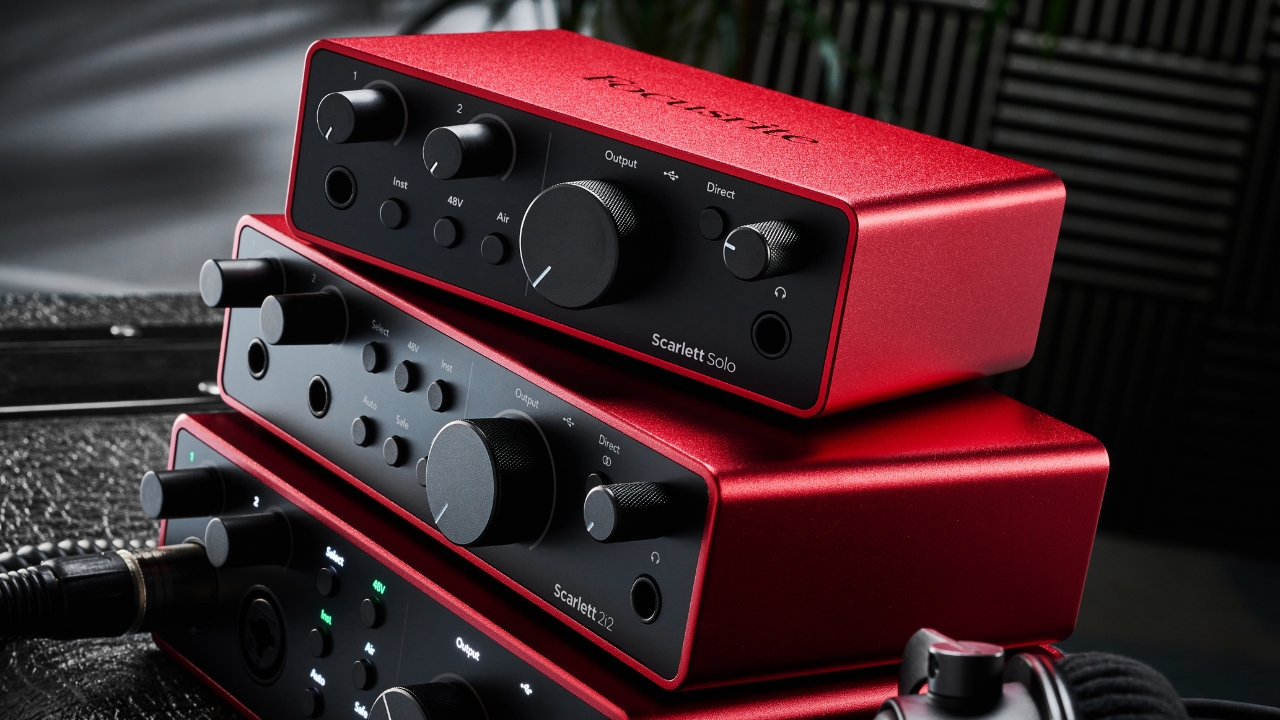
1. The quick list
2. Best for beginners
3. Best for home
4. Best for studio
5. Best for podcasting
6. Best for preamps
7. Best pro option
8. Buying advice
9. How we test
Few names define a product group more than Focusrite does with audio interfaces. For as long as music production and home studios have been a thing, there’s been an army of small (usually red) boxes powering peoples’ recording efforts, routing audio in and out of laptops and tablets quietly and efficiently. We thought, therefore, that a round-up of the best Focusrite audio interfaces was a worthy guide to have, and so here we are.
Whether you’re a full band looking for an expansive multitrack recording partner or a bedroom beatmaker who just wants to ensure the best bang for their buck, there’s a Focusrite for you. We've had plenty of hands-on experience with many different Focusrite audio interfaces, so in this guide we’ll explain the differences between the range, and point out the things you should be looking for when you’re searching for a new audio interface.
Don't know a preamps from phantom power? Then you'll want to check out our buying advice section which has loads of common questions about audio interfaces answered by the experts here at MusicRadar, as well as some interesting history on Focusrite themselves. If you already know your stuff, then keep scrolling for our top picks.
The quick list

If you're new to the world of audio interfaces, then you'll most likely want to start with the Focusrite Scarlett Solo. With just a mic and line input it's easy enough for beginners to use, as well as offering an excellent software bundle to get you started.

If you're upgrading from a beginner audio interface or you just want a more serious hub for a home studio setup, the Focusrite Scarlett 2i2 is an excellent choice. It's excellent value for money too, with more features and connectivity than the Solo.
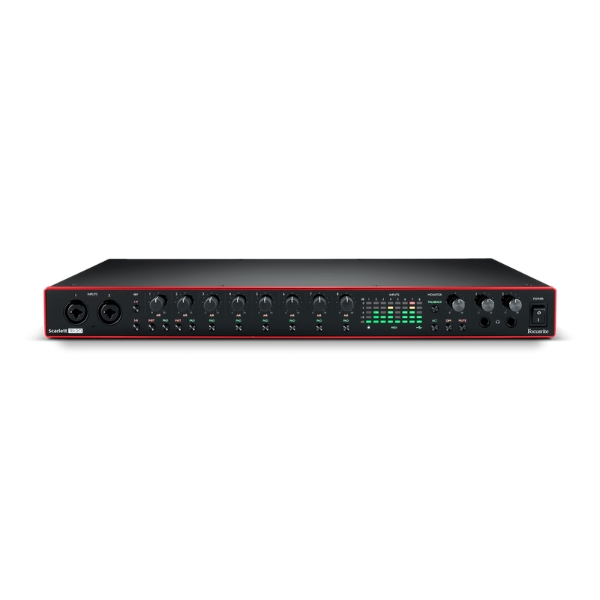
If you want to do more complex multi-track work like recording an acoustic drum kit, the Focusrite Scarlett 18i20 gives you plenty of connectivity. With 8 ins and outs as well as individual compression on each channel, this is a serious bit of kit.

Podcasts are absolutely massive these days, and if you want to start recording your own then the Focusrite Vocaster is a great option. It's got loads of great features like phone input and camera output, as well as loopback making it super versatile.
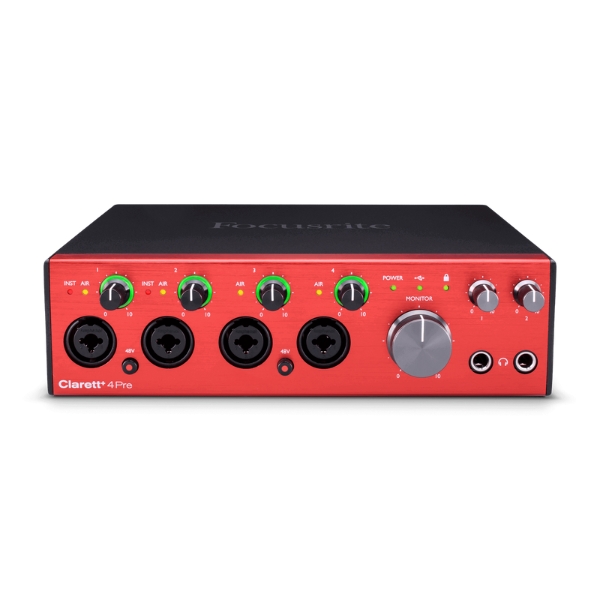
If you're looking for top-quality preamps for your recording set up, the Focusrite Clarett+ 4Pre gives you four of 'em. Perfect for recording vocals, guitar amps, and pretty much anything else, the high headroom and low noise give you exceptional quality.
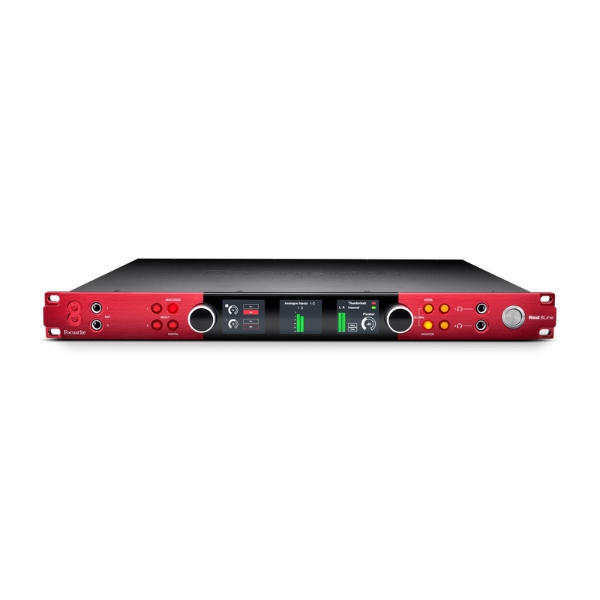
Designed for professional-level audio engineering, the Focsruite Red 8 Line delivers exceptional connectivity and top-level mic preamps for the pros. It's not cheap, but if you demand only the very best for your studio, it's well worth the asking price.
Best for beginners
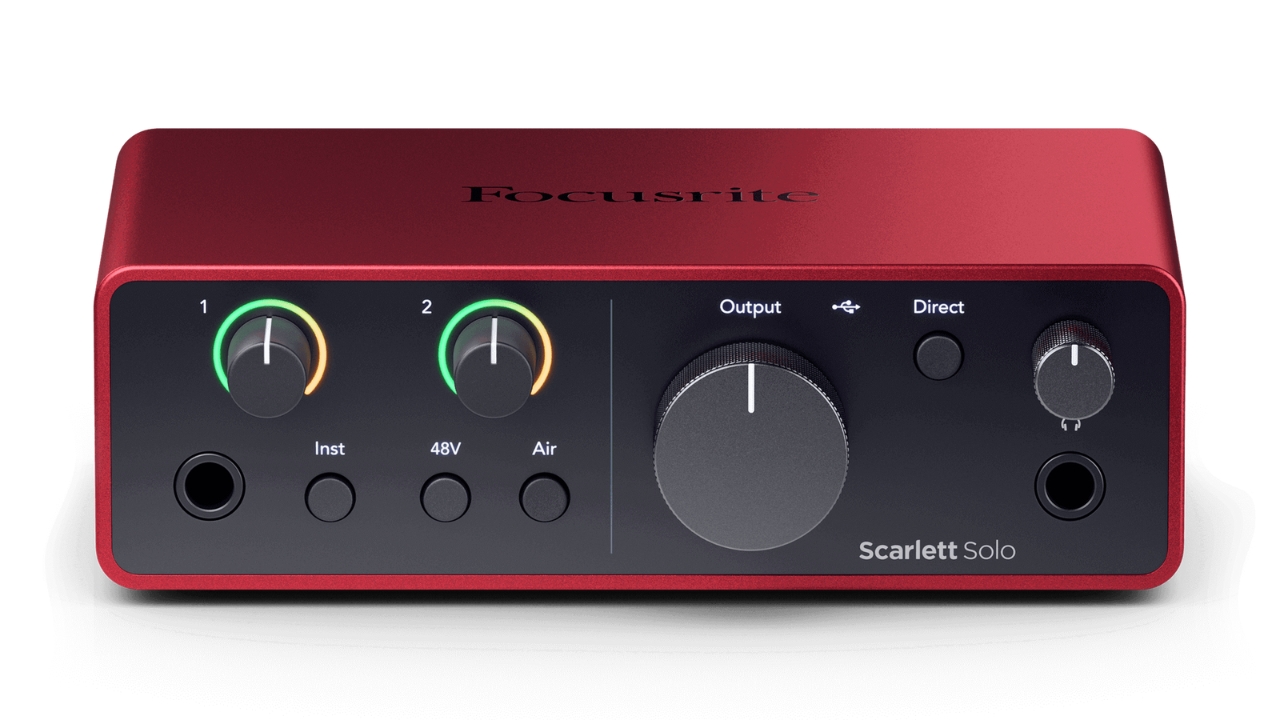
Specifications
Reasons to buy
Reasons to avoid
✅ Buy if you're new to recording: Designed as the entry-level Focusrite interface, the Scarlett Solo is powerful enough to get great recordings, but easy enough for anyone to use.
❌ Avoid if you want to multi-mic: If you're recording anything other than a couple of sources you'll want something with more inputs than this.
Propping up the range is Focusrite’s smallest interface, the Scarlett Solo, which offers up a single high-quality mic preamp (and a regular line-level or instrument input) to give basic set-ups a quick and easy way to upgrade. If you’re dipping your toe into the waters of home recording, and won't need to record more than two sound sources at a time, then the Scarlett Solo is the ideal option.
It offers superb audio quality and is as simple to use as an audio interface could ever be. You plug it in, connect your devices, and away you go. We also like the way it has the same toughened chassis as the more expensive units, so you could quite happily keep one in your luggage as a backup solution or for nights when you’re stuck in a hotel room away from your bigger toys.
The Focusrite Control app offers excellent flexibility for setting up your inputs without having to mess around with the actual knobs and buttons on the front. You also get an excellent software bundle to get you up and running from the moment you open the box.
Read our full Focusrite Scarlett Solo 4th Gen review
Best for home
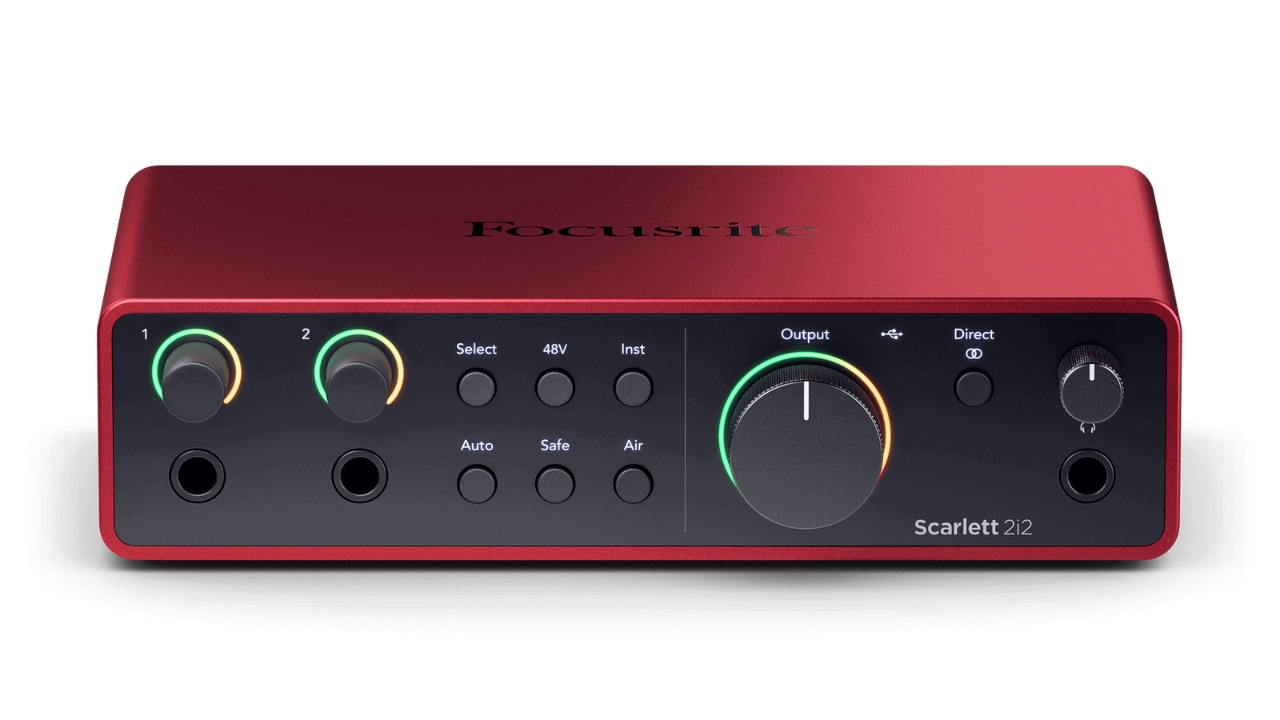
Specifications
Reasons to buy
Reasons to avoid
✅ Buy if you're setting up a home studio: The perfect interface for home studio settings, the 2i2 gives you two mic preamps and loads of useful features to make recording at home a breeze.
❌ Avoid if you want MIDI: There are no MIDI connections here, so you'll want to look elsewhere if you want to incorporate MIDI as part of your recording rig.
While no manufacturer would release sales figures without being under legal duress to do so, it’s safe to assume the Focusrite Scarlett 2i2 is one of, if not the, biggest-selling audio interfaces of all time. Now in its fourth iteration – which itself is an indicator of its popularity – the 2i2 has been refined and finessed into pretty much the best audio interface for basic home studio work.
Packing two quality Focusrite mic preamps, there are lots of additional features designed to make your recording process that much easier. Auto gain sets your input at the perfect level while clip safe prevents your track from accidental clipping. The air function adds a presence boost too, useful for livening up a direct input.
Some of the notable new additions come in the ability to power it from a powerbank thanks to a second USB-C port, meaning it’ll function perfectly with tablets and smartphones, and we also liked the loopback functionality – a clear nod that streamers and vloggers have found the 2i2 ideal for their needs too. A triumph, and easy to recommend.
Read our full Focusrite Scarlett 2i2 4th Gen review
Best for studio
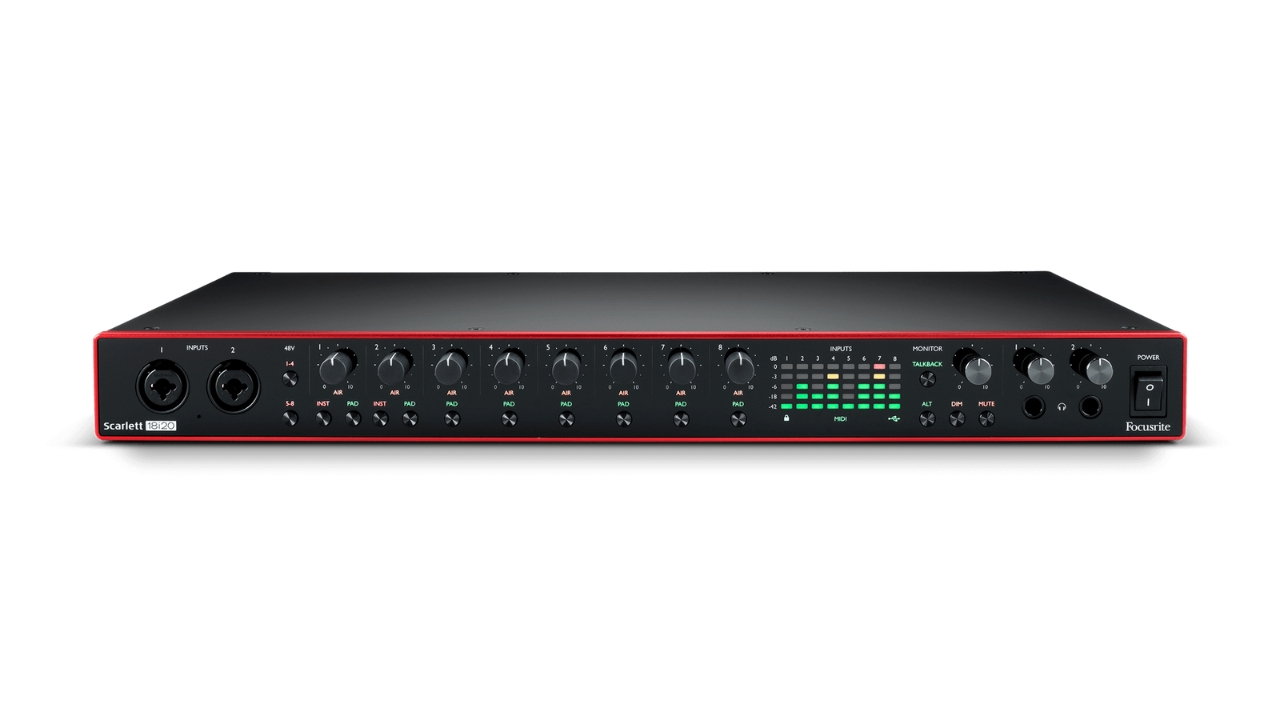
3. Focusrite Scarlett 18i20
Our expert review:
Specifications
Reasons to buy
Reasons to avoid
✅ Buy if you're setting up a more complex studio: With its plentiful connection, the 18i20 is great for more complex multi-mic drum recordings and ensembles.
❌ Avoid if you're short on space: The amount of room and cabling required for this set up means that if you're short on space you might struggle to get the best out of it.
If your studio comprises multiple hardware sound sources, like synths, grooveboxes and electric guitars, and you’re fed up having to unplug everything when you want to record something new, then a larger interface is worth its weight in gold. The Focusrite Scarlett 18i20 is exactly that; an 18-input interface that allows you to connect and record multiple sound sources at once.
If you want to record in a more traditional fashion and take a step up from being a bedroom producer it represents fantastic value for money, offering you plenty of connectivity for recording drums and multi-miking different sources.
On the inside, it’s largely the same, tech-wise, as the smaller Scarlett units, although it does include MIDI I/O for allowing your DAW to communicate with your connected hardware. We also like the fact it can be rack-mounted and can be used without requiring a computer connection like a traditional mixer.
Best for podcasting
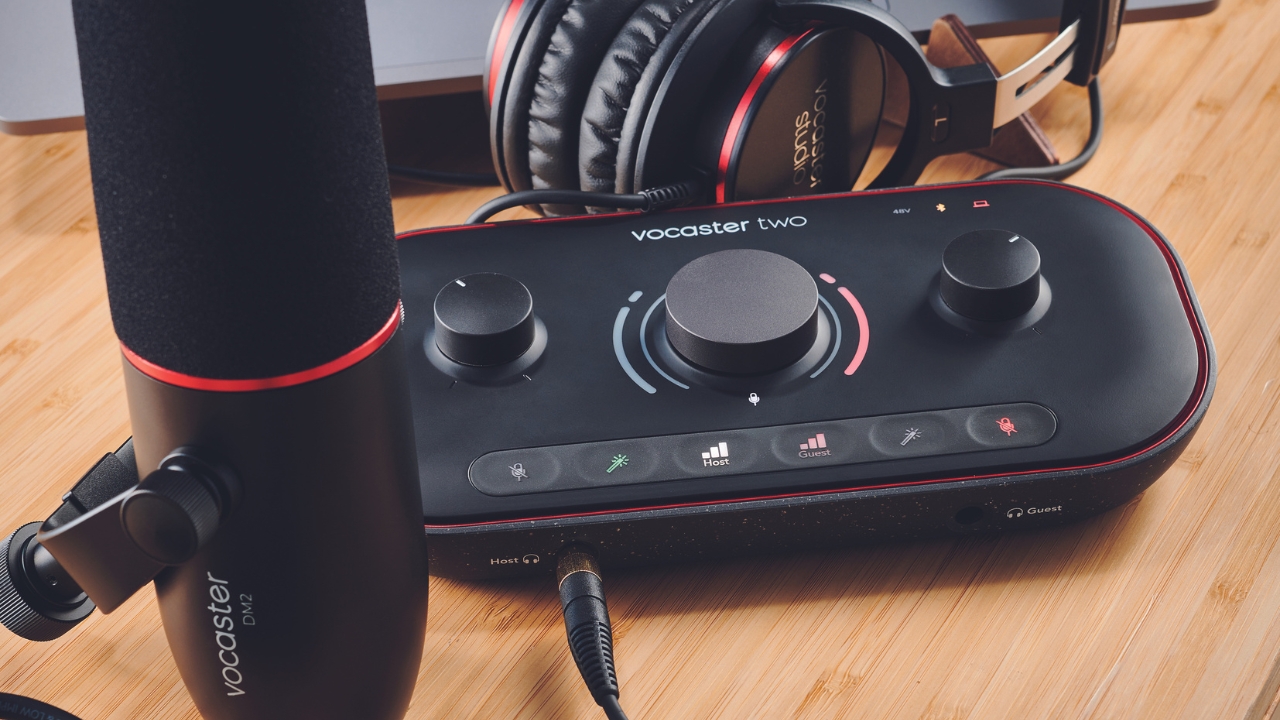
Specifications
Reasons to buy
Reasons to avoid
✅ Buy if you're starting a podcast: Packing loads of podcast-friendly features, the Vocaster is a great choice for recording podcasts, whether that's at a permanent space or on location.
❌ Avoid if you're making music too: It's definitely geared towards podcasters, so not the best for those who want to use their interface to record music as well.
Podcasting has become wildly popular in recent years, and Focusrite has stepped up with a range of interfaces designed specifically for this. In acknowledging many podcasters will come into the pursuit with little or no experience in audio production, Focusrite's Vocaster range is laid out in a simple way to get people recording as quickly as possible.
Here, you’ll find two mic inputs, and then clear controls on top for the gain and headphone levels of each microphone input. A phone input, camera output, and loopback functionality are vital tools for podcasters, making it very complete despite its small size.
We liked the form factor, which is small enough to carry around for on-location recordings, and the confidence you get from knowing Focusrite knows what it's doing, so the quality levels will be more than enough for the vast majority of users.
Best for preamps
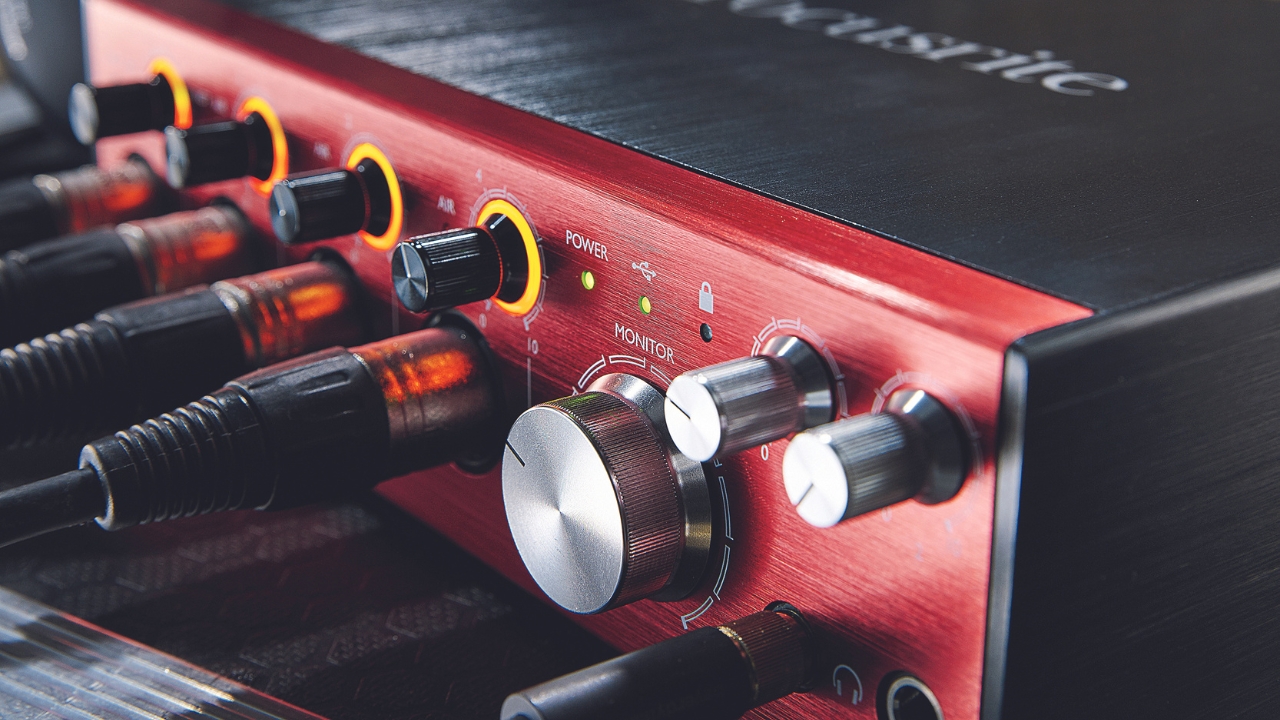
Specifications
Reasons to buy
Reasons to avoid
✅ Buy if you're after the best sound: Coming with some of the best mic preamps that Focusrite makes, the Clarett+ 4Pre will deliver top-quality tones that are great for recording vocals and other instruments.
❌ Avoid if you're on a budget: Ultimately top quality costs top dollar so if you're on a tight budget, you'll want to look elsewhere in the Focusrite range.
While the Scarlett range of interfaces offers superb audio fidelity and usability, for more serious or professional applications there exists the Focusrite Clarett range. We’ve highlighted the Clarett+ 4Pre here, but there are other options with more connectivity in the range.
Essentially though, the extra money gets you higher-grade mic preamps, which deliver cleaner audio with more available headroom to help in post-production. By requiring less in the way of gain, your recordings will sound more pure, which is helpful when layering different vocals, for example.
The Clarett range is more expensive, for sure, but its relatively small size gives it a degree of portability, meaning you can produce pro-level recordings wherever you are without being tethered to the studio environment.
Read our full Focusrite Clarett+ 4Pre review
Best pro option
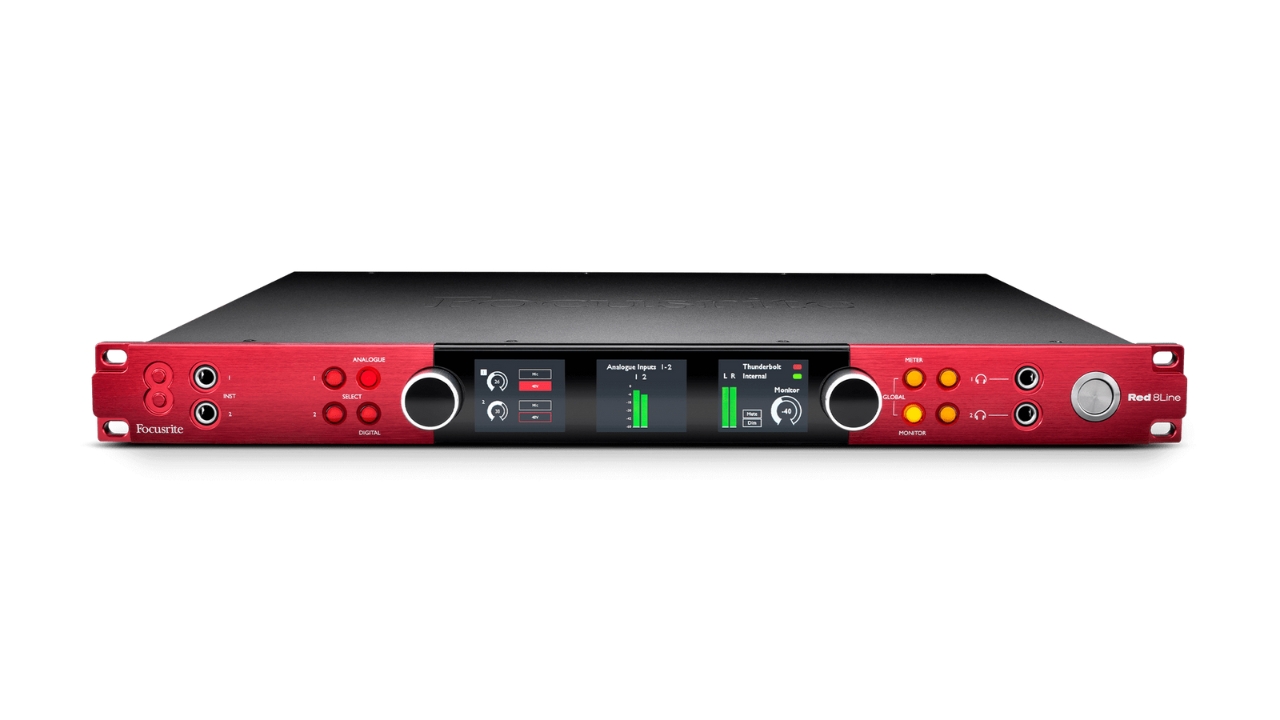
6. Focusrite Red 8 Line
Our expert review:
Specifications
Reasons to buy
Reasons to avoid
✅ Buy if you're setting up a pro studio: With its myriad of connectivity and pro feature set, this is an interface for those who are setting up a dedicated studio space.
❌ Avoid if you're recording at home: If you're still recording at home, chances are this will be much more than you need.
At the top end of the Focusrite range sits the Red interface series. These interfaces are designed with pro-level studio applications in mind and have a feature set to match.
For the money, you get a vast number of inputs and outputs via DB25 or Ethernet connections – more than enough for all but the most extensive sessions – along with direct compatibility with ProTools, ThunderBolt 3 connectivity and a host of other features which elevate it above the more generic interfaces we’ve listed above.
There’ll be a certain type of user the Red series appeals to. One will likely carry out some form of audio engineering as a day job, and will therefore demand the highest levels of performance and reliability, while the other will probably just have a day job that pays enough for them to afford this kind of equipment. Either way, the quality and usability that’s on offer here will surely appeal to both categories.
Buying advice

What do I need an audio interface for?
Fundamentally, audio interfaces are relatively simple things. They act as the simple method of getting audio in, and out, of your laptop’s recording software. At a basic level, you plug something into the front – be that a guitar, microphone or synth – and then the interface converts your analogue signal into a digital one that can be read by your software. Then, it reverses this process to convert digital audio back into analogue so it can be played out through headphones or audio monitor speakers.
What does Focusrite do?
Focusrite make audio interfaces, although they haven't always done that. Founded in 1985 by the legendary Rupert Neve, Focusrite began manufacturing consoles for recording studios. Since then, they've grown to become one of the biggest audio companies in the modern world. Nowadays they primarily manufacture audio interfaces, and the Scarlett range are some of the best selling units in the world.
Why is Focusrite so popular?
It's likely a combination of factors that has led to the popularity of Focusrite exploding. Their effective audio interfaces are both easy to use and accessible to the majority of musicians, which probably accounts for a large part of that popularity. Their excellent heritage as we mentioned previously almost certainly counts for something too, with their founder Rupert Neve being one of the biggest names in pro audio.
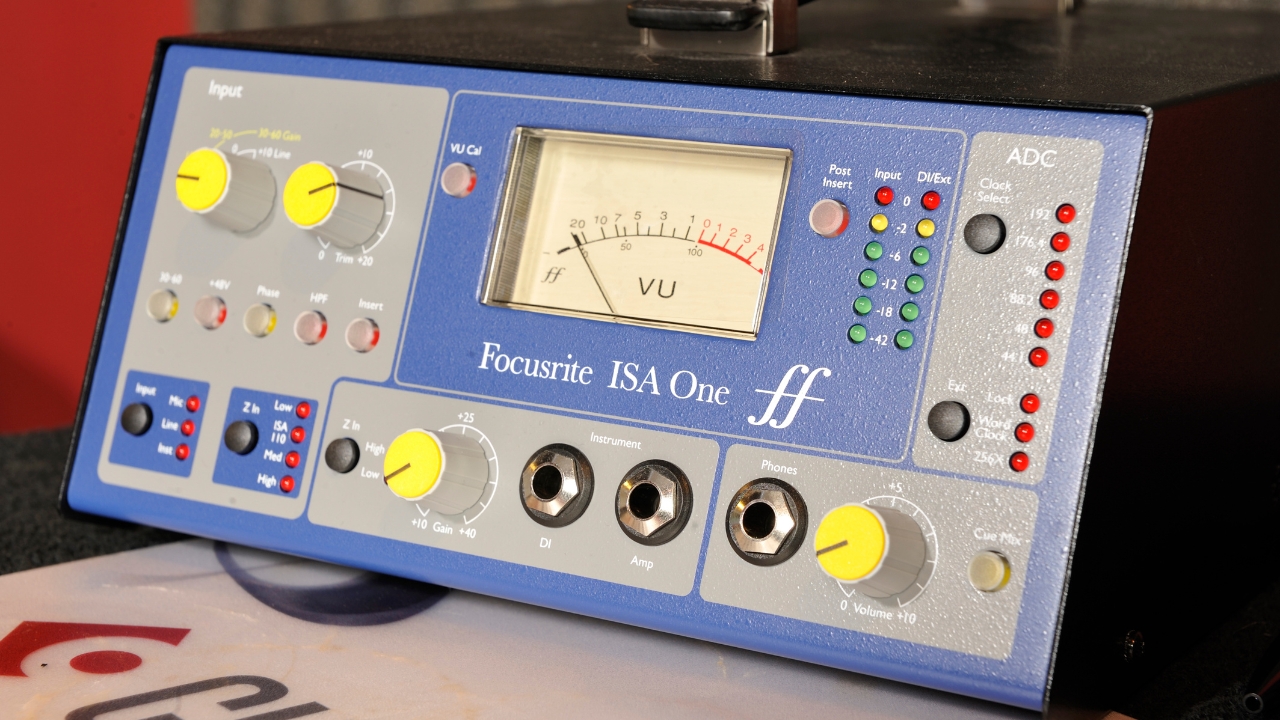
What connectivity do I need?
Audio interfaces are connected to your computer via USB, so when we talk about connectivity in this context, we mean the number of inputs and outputs you have available to use. For a solo recorder, requiring maybe just a single microphone and a guitar, a basic two-channel input will suffice. For full bands, or for more complex recordings, an interface with eight or more inputs will be required. As your audio software will read each input as its own track in a multitrack session, the more inputs you have means the more tracks you can record concurrently.
Look too for the type of inputs. Microphones will require XLR connectivity, along with preamps in the unit to help boost the signal before it’s converted into digital. Thankfully, Focusrite preamps are regarded as among the best in the business so you can be confident the quality will be high with these. Elsewhere, guitars and line-level inputs will require 1/4” (3.5mm) jack inputs. Often XLR and jack connections are doubled up, meaning one can act as either, increasing their versatility. Look as well for the ability to provide phantom power, i.e. a 48v bump required to make condenser microphones operate properly.
As well as the inputs, look at the number of connections you require for getting audio out of your computer. Alongside the obvious methods of using headphones or monitor speakers, it may be that you want the option to route audio from the computer out towards external hardware, like sending a synth sound out to a guitar pedal, and then back into the interface. Higher end interfaces allow for a degree of fairly complex routing, often managed within the interface’s accompanying software. Focusrite interfaces come bundled with Focusrite Control, which performs this exact process in a simple, visual way.
How much should I spend on an audio interface?
Naturally, budget comes into the conversation at some point. Focusrite has always done well on this front, offering both high-end interfaces designed for pro-grade applications, and basic, budget interfaces for use in home studios. While budget and expensive interfaces will all function in the same basic way, the differences will become apparent in the audio quality of your recordings, and in the number of tracks you can record at the same time. The trick is for you to decide which interface will suit your particular needs. If you have an extensive hardware set-up, with synths and drum machines all functioning at the same time, then it makes sense to spend on an interface that can allow you to record quickly without having to plug and unplug different machines each time, therefore speeding up your workflow.
How we test
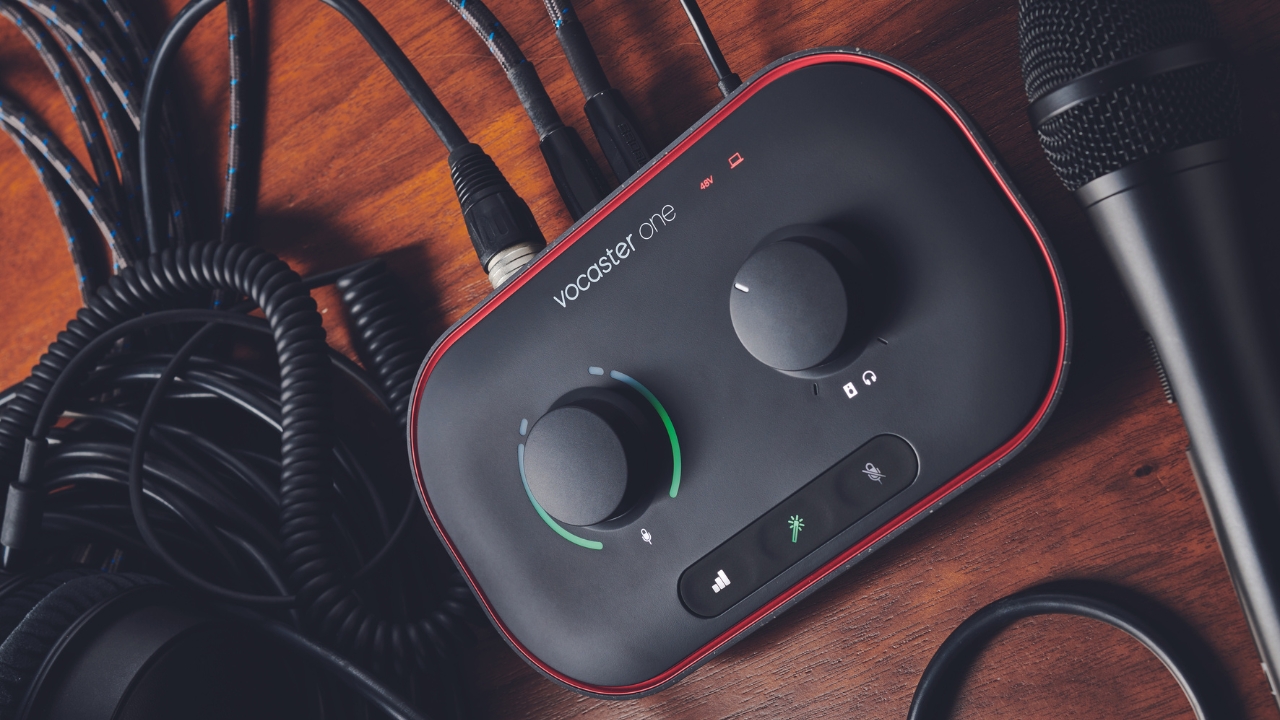
When we test an audio interface, whether it's one from Focusrite or not we'll always put it through the same strenuous processes as any bit of gear that crosses our desk. An audio interface is the hub of any home recording studio and as such, needs to be reliable.
First of all, we'll look at how easy it is to setup and use the interface in question. Most audio interfaces are plug and play, but that doesn't mean there aren't extra steps that need to be taken. We'll always take into account how easy it is to set things up, checking on both Windows and Mac and documenting any additional requirements.
Next we'll look at the general usability in a variety of situations. Whether it's looking at loopback to handle podcasting duties or any useful features that make recording instruments easier we'll test the interface at home and in dedicated recording spaces to see how easy it is to use. All of our authors are producers and musicians themselves, so an interface will always get used as part of our daily lives making music, content, or anything else.
Finally we'll look at overall performance. Does the interface operate well at low latency? Are the preamps clear? Does it have enough headroom to mic up a loud sound source? These are some of many questions we'll ask of any audio interface when testing, making sure to test every aspect of the unit.
Read more about how we test audio interfaces at MusicRadar.
Related buyer's guides
MusicRadar's got your back
- Augment your setup with one of the best MIDI keyboards
- Get great sound with the best studio monitors
- Check out our pick of the best budget audio interfaces
- Fix your low end with the best studio headpones
Want all the hottest music and gear news, reviews, deals, features and more, direct to your inbox? Sign up here.
Chris Corfield is a journalist with over 12 years of experience writing for some of the music world's biggest brands including Orange Amplification, MusicRadar, Guitar World, Total Guitar and Dawsons Music. Chris loves getting nerdy about everything from guitar and bass gear, to synths, microphones, DJ gear and music production hardware.
- Matt McCrackenJunior Deals Writer
